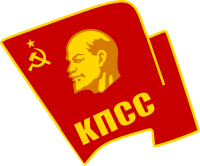
Back اللجنة المركزية للحزب الشيوعي السوفيتي Arabic اللجنه المركزيه للحزب الشيوعى السوفيتى ARZ Sovet İttifaqı Kommunist Partiyası Mərkəzi Komitəsi Azerbaijani КПСС Үҙәк Комитеты Bashkir Цэнтральны камітэт КПСС Byelorussian ЦК КПСС BE-X-OLD ЦК на КПСС Bulgarian Comitè Central del Partit Comunista de la Unió Soviètica Catalan Ústřední výbor Komunistické strany Sovětského svazu Czech ZK der KPdSU German
 | |
| Information | |
|---|---|
| General Secretary | Joseph Stalin |
| Elected by | Congress |
| Responsible to | Congress |
| Child organs | |
| Meeting place | |
 | |
| Grand Kremlin Palace, Moscow Kremlin[1][2][3] | |
The Central Committee of the Communist Party of the Soviet Union[a] was the highest organ of the Communist Party of the Soviet Union between two congresses. According to party statutes, the committee directed all party and governmental activities. The Party Congress elected its members.
During Vladimir Lenin's leadership of the Communist Party, the Central Committee functioned as the highest party authority between Congresses. However, in the following decades the de facto most powerful decision-making body would oscillate back and forth between the Central Committee and the Political Bureau or Politburo (and during Joseph Stalin, the Secretariat). Some committee delegates objected to the re-establishment of the Politburo in 1919, and in response, the Politburo became organizationally responsible to the Central Committee. Subsequently, the Central Committee members could participate in Politburo sessions with a consultative voice, but could not vote unless they were members. Following Lenin's death in January 1924, Stalin gradually increased his power in the Communist Party through the office of General Secretary of the Central Committee, the leading Secretary of the Secretariat. With Stalin's takeover, the role of the Central Committee was eclipsed by the Politburo, which consisted of a small clique of loyal Stalinists.
By the time of Stalin's death in 1953, the Central Committee had become largely a symbolic organ that was responsible to the Politburo, and not the other way around. The death of Stalin revitalised the Central Committee, and it became an important institution during the power struggle to succeed Stalin. Following Nikita Khrushchev's accession to power, the Central Committee still played a leading role; it overturned the Politburo's decision to remove Khrushchev from office in 1957. In 1964 the Central Committee ousted Khrushchev from power and elected Leonid Brezhnev as First Secretary. The Central Committee was an important organ in the beginning of Brezhnev's rule, but lost effective power to the Politburo. From then on, until the era of Mikhail Gorbachev (General Secretary from 1985 to 1991), the Central Committee played a minor role in the running of the party and state – the Politburo once again operated as the highest political organ in the Soviet Union.
For the majority of Central Committee's history, plenums were held in the meeting chamber of the Soviet of the Union in the Grand Kremlin Palace. The offices of the administrative staff of the Central Committee were located in the 4th building of Staraya Square in Moscow, in what is now the Russian Presidential Administration Building.
- ^ "Пленум ЦК КПСС 27-28 января 1987 года". ria.ru. MIA "Russia Today". 27 January 2017. Retrieved 27 February 2018.
- ^ "Красное Знамя" (PDF). sun.tsu.ru. Body of the Tomsk Regional Committee of the CPSU and the Regional Soviet. Retrieved 10 June 2021.
- ^ Maksimenkov, Leonid (12 November 2012). "Ivan Denisovich in the Kremlin". kommersant.ru. AO Kommersant. Retrieved 10 June 2021.
Cite error: There are <ref group=lower-alpha> tags or {{efn}} templates on this page, but the references will not show without a {{reflist|group=lower-alpha}} template or {{notelist}} template (see the help page).
© MMXXIII Rich X Search. We shall prevail. All rights reserved. Rich X Search